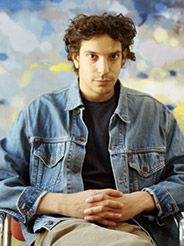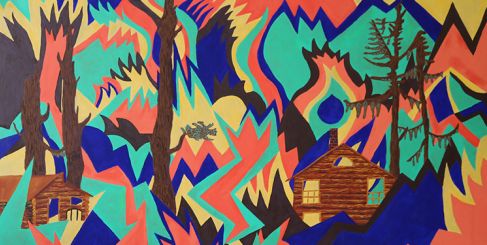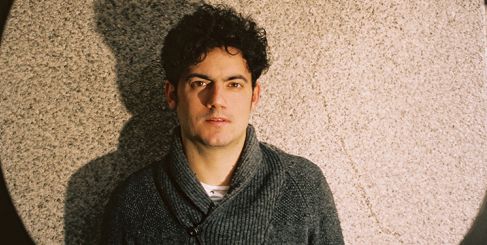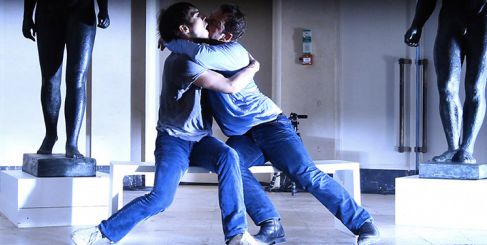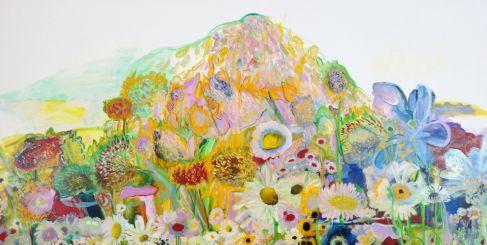News
Galerie Eva Hober: GIORGIO SILVESTRINI’S MESMERISING MISES EN SCÈNES

For this, his second solo exhibition at the galerie Eva Hober, which runs from 6 September to 5 October, Giorgio Silvestrini presents a new series of paintings inspired by traditional still lifes and metaphysical painting. Also depicted are models created by the artist himself, reproductions of well-known works of art, and, for the first time, human figures.
Made up of small pieces of dowling, bits of coloured fabric and crumpled paper, Giorgio Silvestrini’s models resemble slender flowers, branches, succulents, clouds or even fragile marionnettes. The artist offers us a bird’s eye view of them, placed upon tables and folds of fabric, where they play off against small-scale sculptures (Derain, Giacometti, Arturo Martini…), which the artist first photographed, then used to further inspire himself in his works. Taken as a whole, the scenes create partnerships of multiple mysterious objects, between which subtle yet well-defined connections may be glimpsed… For instance, there is a recurring motif, that of striped fabrics. In contrast, in Sarabanda, the juxtaposition of hard and yielding materials creates of sort of paradox in the shape of a plant with prickly leaves in a velvet-covered vase. Pastel colours, reminiscent of Italian Renaissance tempera wall paintings, together with diffuse lighting, bring a final note of equilibrium to the compositions of Giorgio Silvestrini, plunging us into a softer, cosier ambiance.
Although tremendous attention is paid to texture, if you look very carefully, you’ll discover that the real originality of Giorgio Silvestrini’s work appears in his spatial positioning of the objects he paints. Either spaces are used as a kind of stage where harlequins, puppets and marionettes parade, or, alternatively, they are represented as a kind of theatre of the absurd where combinations of objects and the mental associations they provoke leave the viewer pondering a number of as yet unresolved riddles… However, Giorgio Silvestrini’s still lifes do offer some clues, by affording us a sneak peek at the tricks that underpin them. Objects such as houses of cards, balls and pick-up-sticks are potential symbols for the idea that it’s all one big construction set. Meanwhile, a dark-coloured curtain slips down, revealing that the starry sky behind the three delicate vases is just an illusion…
What’s yet more noteworthy is the high horizon line used in the depictions of the tables on which the still lifes are placed. The knick-knacks, plants and sculptures that are strewn upon the tables are somehow side-by-side yet do not seem to quite share the same vanishing point. This is Giorgio Silvestrini’s way of defying the traditional rules of perspective. Instead he opts for a more complex approach to how he uses space, namely by adopting reverse perspective, bird’s eye views and positioning objects further away from the viewer – causing them to appear larger. ‘What I find interesting is to see what happens when different objects are shown side-by-side – to see what kind of synergy, what dynamic is created’, the artist notes. He also plays upon the different meanings of his exhibition’s name. Auto-Reverse could be interpreted as meaning a self-portrait created by a painter through the objects that he is fond of and would like to combine, a meaning that is almost becomes an atonymn - rather like the use of perspective in some of his paintings.
That said, the meaning invested in Giorgio Silvestrini’s paintings is derived from more than just the spatial relationships that he creates between objects. His works are imbued with something of a mystic, spiritual quality similar to that seen in the still lifes of the Spanish Golden Age and those of Francisco de Zurbarán, which he studied during his artists’ residence at the Casa de Velázquez (2016-2017). As a result, sobriety, balance and density characterize Giorgio Silvestrini’s most recent works, which feature often ordinary objects that nonetheless have an aura of intensity about them. It’s also true to say that the influence of De Chirico’s metaphysical painting is significant. It’s as if Giorgio Silvestrini is inviting us to look beyond the mere appearance of things, asking us if there could be other meanings hidden behind what we can initially see. In regard to this, the initial presence of human figures in his paintings has contributed to the innovation of each scene with even more life, being actors capable of interacting with and exploring objects - giving his still lifes a livelier, more complex story to tell.
François Salmeron

